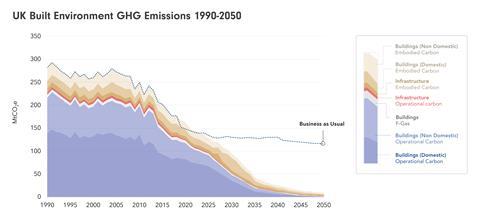Detailed roadmap launched at COP26 today by coalition of architects and other construction professionals
A net zero built environment sector by 2050 is achievable – but only with urgent government action, the UKGBC will tell world leaders at COP26 today.
More than 100 organisations led by the UK Green Building Council were today due to publish a Net Zero Whole Life Carbon Roadmap for the nation’s built environment detailing the necessary actions they say government and industry must take to achieve net zero across the sector.

Former RIBA president and UKGBC chair Sunand Prasad will be on a panel with Lord Callanan, the minister for business, energy and corporate responsibility, at an event in the main COP26 venue to launch the report on COP’s dedicated day for cities and the built environment.
The roadmap sets out a shared vision and set of actions for achieving a net zero UK built environment by 2050, in relation to construction, operation and demolition of buildings and infrastructure. This will allow the UK to benchmark progress over the years ahead.
> Listen to the Building Talks Net Zero podcast series
> Tight margins not an excuse for avoiding action on net zero, Skanska boss tells firms
It quantifies, for the first time, the specific emission reductions across sub-sectors of the built environment that will need to take place year-on-year to meet the 2050 deadline set by the UK government.
It argues that only with urgent measures and intervention can the UK deliver on its interim target to cut 78% of emissions by 2035.
The analysis includes not only domestic emissions but emissions related to the consumption of imported construction products and materials.
Julie Hirigoyen, chief executive of the UKGBC, said the roadmap went beyond the government’s recent Heat and Buildings Strategy which disappointed many.
“After all the talk, it’s time for action,” she said. “The UK government’s Heat and Buildings Strategy is a step in the right direction but fails to address several key priorities that this analysis clearly demonstrates are non-negotiable to achieving a net-zero carbon built environment by 2050.”
The report pulled together disparate strands of recent policy and action into one coherent pathway, she said, with clear recommendations for national and local government, as well as the private sector and the wider industry.
“We urge policy-makers and industry to embed these recommendations into policies and strategies to make good on the promises and commitments of COP26,” she said.
Many of the recommendations align with existing industry initiatives such as Construct Zero from the Construction Leadership Council, and the Construction Industry Council’s Climate Action Plan, she said.
Construction will today take centre stage at the event and focus on the built environment, which contributes around 40% of global carbon emissions.

The recommendations include
1) Nationwide retrofitting of existing homes.
• Establish an immediate national programme of “fabric first” home retrofit to make homes efficient, warm, and transition away from fossil fuel heating.
• Bring forward the cut-off date for the sale of gas and oil boilers to 2030.
• Reform EPCs and introduce minimum EPC ratings for homes at point of sale by 2028.
• Remove VAT on energy efficient retrofit building works and introduce variable stamp duty linked to energy performance.
• Introduce direct government retrofit grants for low-income households.
2) Energy performance disclosure for non-domestic buildings.
• Introduce mandatory in-use energy disclosure for non-domestic buildings.
• Accelerate the roll-out of energy performance rating schemes across non-domestic sectors, followed by minimum standards and fiscal incentives.
3) Adoption of a design for performance approach to new buildings.
• Reform building regulations to introduce Energy Usage Intensity (kWh/m2/yr) targets for new buildings from 2025.Alongside low carbon heating for all new buildings from 2025, introduce space heating demand limits (kWh/m2/yr), measures to limit peak demand, and minimum standards for currently unregulated key appliances.
4) Whole life carbon measurements and agreed limits.
• Introduce the regulation of embodied carbon for new buildings and major refurbishments
• Support and invest in industrial decarbonisation of key construction material supply chains
• Use planning reforms to prioritise reuse of existing buildings and assets
5) National infrastructure investment based on the net emissions impact.
• Establish a National Infrastructure Integrator with full oversight of carbon impacts




























No comments yet